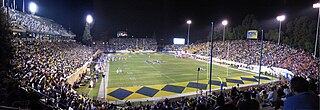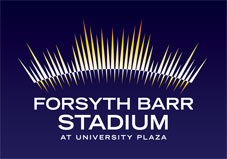
Arrowhead Stadium is an American football stadium in Kansas City, Missouri, United States. It primarily serves as the home venue of the Kansas City Chiefs of the National Football League (NFL). The stadium has been officially named GEHA Field at Arrowhead Stadium since March 2021, following a naming rights deal between GEHA and the Chiefs. The agreement began at the start of the 2021 season and ends in January 2031 with the expiration of the leases for the Chiefs and Royals with Truman Sports Complex owner, the Jackson County Sports Complex Authority.

Gauteng is one of the nine provinces of South Africa.

Kaizer Chiefs Football Club are a South African professional football club based in Naturena, Johannesburg South, that plays in the Betway Premiership. The team is nicknamed AmaKhosi, which means "Kings" or "Chiefs" in Zulu, and the Phefeni Glamour Boys. Chiefs have won 13 league titles and over 42 cup trophies. The club's most recent trophy was the Shell Helix Ultra Cup trophy it won on 12 October 2019. As a result, they hold the most trophies amongst all clubs in South Africa and are the most successful team in South African football history since the start of the top flight in 1970. They are the most supported club in the country, drawing an average home attendance of 16,144 in the 2019–20 season, the highest in the league. It led to them being dubbed "The Biggest Club" in Southern Africa. The team plays its home matches at the 94,797-capacity FNB Stadium.

Gillette Stadium is a multi-purpose stadium located in Foxborough, Massachusetts, United States, which is 22 miles (35 km) southwest of downtown Boston, Massachusetts and 18 miles (29 km) northeast of Providence, Rhode Island. It serves as the home stadium and administrative offices for both the New England Patriots of the National Football League (NFL) and the New England Revolution of Major League Soccer (MLS). It opened in 2002, replacing the adjacent Foxboro Stadium. It also served as the home venue for the University of Massachusetts (UMass) Minutemen football team in 2012 and 2013, while on-campus Warren McGuirk Alumni Stadium underwent renovations; it continued to serve as a part-time home venue for higher attendance UMass games through 2018. Gillette Stadium's seating capacity is 64,628, including 5,876 club seats and 82 luxury suites.

CEFCU ('sef-kyü) Stadium, formerly known as Spartan Stadium, is an outdoor athletic stadium on the west coast of the United States, located in the Spartan Keyes neighborhood of central San Jose, California. Owned by San José State University, the venue is the longtime home of Spartan football; it also hosts the university's commencement ceremony on Memorial Day weekend, and occasional high school football games. Known as Spartan Stadium for over eight decades, it was renamed in 2016.

The Estadio Universitario, nicknamed El Volcán, is a football stadium located on the campus of the Universidad Autónoma de Nuevo León in San Nicolás de los Garza, Nuevo León, Mexico, in the metropolitan area of Monterrey.

Stanley Park was a proposed football stadium in Stanley Park, Liverpool. If built, it would have become home to the Liverpool Football Club. It would have replaced their current stadium at Anfield. The stadium had a planned capacity of 60,000 all-seated. It was also potentially expandable to 73,000 or more.

Aspmyra Stadion is a football stadium in Bodø, Norway. Home of Bodø/Glimt and Grand Bodø, it holds a seated capacity for 8,270 spectators. The venue has four stands: a modern all-seater with roof, 100 club seats and 15 luxury boxes to the south, unroofed all-seater stands to the east and west and two stands to the north. An older raised grandstand with roofing at the back and a new all-seater unroofed stand in front. Before this new stand was built the area in front of the old stand was a standing area that could hold approximately 2000 people, but did not fulfill UEFA safety regulations for international matches. The venue has floodlights and artificial turf with under-soil heating. Immediately south of the venue lies Aspmyra kunstgressbane, a training pitch with artificial turf. Aspmyra Stadion has hosted one Norway national football team match, against Iceland in 2002.
The Rand Stadium is a stadium in Rosettenville, a suburb of Johannesburg, South Africa. It was completely rebuilt, to FIFA specifications, and reopened in August 2008, set to be utilized as a training field for teams participating in the 2010 FIFA World Cup. Despite the relatively small capacity, it is regarded as one of the best playing surfaces in the country.

Huntington Bank Stadium is an outdoor stadium located on the campus of the University of Minnesota in Minneapolis, Minnesota, United States. The stadium opened in 2009, after three years of construction. It is the home field of the Minnesota Golden Gophers of the Big Ten Conference.

First National Bank Stadium or simply FNB Stadium, also known as Soccer City and The Calabash, is an association football (soccer) and Rugby union stadium located in Nasrec, bordering the Soweto area of Johannesburg, South Africa. The site is managed by Stadium Management South Africa (SMSA) and is home of Kaizer Chiefs F.C. in the South African Premier Soccer League as well as the venue for key fixtures for the South Africa national football team.

The Mbombela Stadium is a football and Rugby union all-seater stadium in Mbombela in the Mpumalanga province of South Africa. It was one of 10 venues for the 2010 FIFA World Cup and one of 5 newly constructed stadiums for the tournament. It is the home ground to TS Galaxy and the Pumas. It is an all-seater stadium, with 43,500 seats, almost all under roof.

BMO Field is an outdoor stadium located at Exhibition Place in Toronto, Ontario, Canada. Constructed on the former Exhibition Stadium site and first opened in 2007, it is the home field of Toronto FC of Major League Soccer (MLS) and the Toronto Argonauts of the Canadian Football League (CFL). BMO Field is owned by the City of Toronto and managed by Maple Leaf Sports & Entertainment, which owns both Toronto FC and the Argonauts. The stadium's naming rights are held by the Bank of Montreal, which is commonly branded as "BMO". It is one of two Canadian stadiums which will host matches of the upcoming 2026 FIFA World Cup. An expansion for the tournament will bring the stadium's capacity to 45,736 seats.

FMG Stadium Waikato is a major sporting and cultural events venue in Hamilton, New Zealand, with a total capacity of 25,800. Four areas contribute to this capacity: The Brian Perry Stand holding 12,000, the WEL Networks Stand holding 8,000, the Goal Line Terrace holding 800 and the Greenzone can hold up to 5,000 people. The capacity can be extended, however, by temporarily adding 5,000 seats to the Goal Line Terrace area. The stadium, owned by the Hamilton City Council, regularly hosts two rugby union teams:

The Nelson Mandela Bay Stadium is a soccer and rugby union stadium in Gqeberha in the Eastern Cape province of South Africa. It hosted 2010 FIFA World Cup matches, including the third-place play off. It is the home of Chippa United Football Club and formerly of rugby union team Southern Kings.

Levi's Stadium is an American football stadium located in Santa Clara, California, just west of the much larger city of San Jose, in the San Francisco Bay Area. It has served as the home venue for the National Football League (NFL)'s San Francisco 49ers since 2014. The stadium is located approximately 40 miles (64 km) south of San Francisco. It is named after Levi Strauss & Co., which purchased naming rights in 2013.

U.S. Bank Stadium is an enclosed stadium located in downtown Minneapolis, Minnesota. Built on the former site of the Hubert H. Humphrey Metrodome, the indoor stadium opened in 2016 and is the home of the Minnesota Vikings of the National Football League (NFL); it also hosts early season college baseball games of the University of Minnesota Golden Gophers.

Onismor Bhasera is a Zimbabwean professional footballer who plays as a left-back for SuperSport United in the South African Premier Soccer League. He previously played in the South African Premier Division for Bidvest Wits, Maritzburg United and Kaizer Chiefs, and the Football League for Plymouth Argyle. Bhasera has won caps at full international level for Zimbabwe.

Forsyth Barr Stadium is a multi-purpose stadium in Dunedin, New Zealand. At various stages of development it was also known as Dunedin Stadium or Awatea Street Stadium, or its non-commercial official name during the 2011 Rugby World Cup and 2015 FIFA U-20 World Cup, Otago Stadium. The fully covered stadium is also known colloquially as 'The Glasshouse' due to its resemblance to a horticultural hothouse.
Kaizer Chiefs Development is a South African football (soccer) club based in Johannesburg that plays in the DStv Diski Challenge.



















